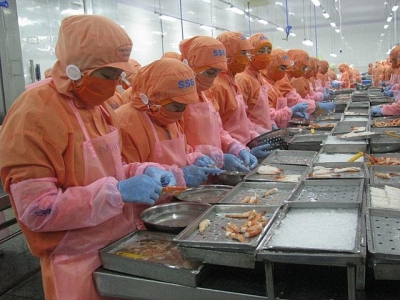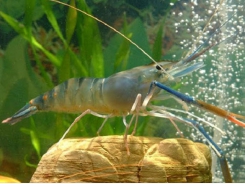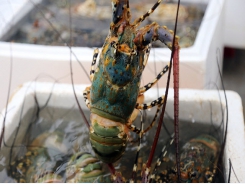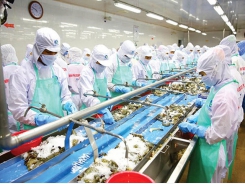Will seafood exports reach over US$ 8 billion?

Despite many efforts, in the context of overwhelming difficulties and impact from the Covid-19 pandemic since the beginning of the year, seafood exports for the whole year are expected to "reach the target" of about US$ 8.2 billion, significantly lower than the target of US$ 10 billion set at the beginning of the year.
The price of the main exported seafood products, shrimp and pangasius, has recorded many positive signals.Photo: Nguyen Thanh
Not meeting export target
According to the latest information from the Department of Agricultural Product Processing and Market Development (Ministry of Agriculture and Rural Development), from the beginning of the year to the end of October 2020, the seafood export value reached nearly US$6.88 billion, down 2.5%compared to the same period in 2019.
The top four import markets of Vietnamese seafood in the first nine months of 2020, accounting for 59.7% of the total seafood export value, were the United States (up 8.5%);Japan (down 3.2%);China (up 0.1%) and South Korea (down 1.2%).
Notably, in the domestic market, the price of raw pangasius in the Mekong Delta provinces in October 2020 has recovered quite strongly, fluctuating around VND21,000-22,000 / kg for grade I pangasius (700-900g / unit), increasing about VND4,000 / kg compared to the previous month.
The pangasius market is more active when the processing factories carry out many contracts to catch fish from outside while the supply is not available.Pangasius import demand in major markets is showing signs of recovery after a sustained quiet period.
"The Covid-19 pandemic had a strong impact on the shrimp industry when the food service business decreased by 80-90%. However, in the last months of the year, the shrimp market showed signs of recovery but still it slowed down," Mr. NguyenQuoc Toan, Director of Agro Processing and Market Development Department, said.
Resolutely remove the "yellow card"
Besides the market difficultiescaused by the Covid-19 pandemic, the most painful issue at the moment is removing the "yellow card" of seafood from the EU.In the context that the EU is one of the major export markets of Vietnamese seafood and the Vietnam-EU Free Trade Agreement (EVFTA), which takes effect from August 1, 2020, opens up many opportunitiesfor this billion-dollar industry, the issue of quickly removing the "yellow card" is even more urgent.
Deputy Minister of Agriculture and Rural Development Phung Duc Tien said that after three years the European Commission (EC) warned of the "yellow card" for Vietnamese seafood products, exports to the EU market were significantly affected, and decreased continuously through the years. Specifically, in 2018, it decreased by 6% compared to 2017; in 2019, down 15% compared to 2018; in the first nine months of 2020, a decrease of 13% compared to the same period in 2019.
It is forecasted that for the whole 2020, the export value of seafood to the EU may reach US$340 million, down 10% compared to 2019 and sales decrease by 28% compared to in 2017.
"After Vietnam received the "yellow card", the EU from the second position in the top of Vietnam's seafood import markets has dropped to the fifth market since 2018, behind Japan. The US, South Korea and ASEAN, in particular, the "yellow card" warning by the EC has affected the reputation of Vietnam and the fisheries sector in the international arena," the MARD leaders said.
Answering recent questions from National Assembly deputies about the solution to remove the "yellow card", Minister of Agriculture and Rural Development Nguyen Xuan Cuong stated that after nearly three years, all legal documents and 11 recommendations of the EC have been put into the institution by the Fisheries Law, Decree, Circular issued.In terms of action, Vietnam has conducted an investigation with reserves of more than 4.5 million tons of seafood as a basis for planning the development of vehicles and catches.
For centralized fleet management, Vietnam has a total of 31,600 ships of 15m in length or more, operating in the EU regulated areas.Currently, the installation of cruise monitoring equipment is important to control, but on average only about 84% have been installed.The entire infrastructure, including fishing ports and anchorage zones in Vietnam, has not beenguaranteed, also affects control.
Notably, the minister of the agricultural sector emphasized that: "Regarding the violation of fishing ships, the Pacific region has absolutely no Vietnamese ships, but the southern sea area this year still has 73 violations.This is a taboo thing because if you violate, you can never remove the yellow card.”
According to the Minister of Agriculture and Rural Development, this ministry has made a full report on the measures, the Secretariat has issued a Directive, the Government is also focusing on implementing to improve the mining institutions, including a solutions group.Another big thing is to restructure in the direction of focusing on marine farming to minimize pressure on fishing activities.
To remove the "yellow card" quickly, many experts said that that in addition to the moves from state management agencies, the seafood business community must also continue to closely coordinate with state management agencies,strictly implementing regulations against illegal, unreported and unregulated (IUU) fishing;resolutely refuse to purchase, process and export aquatic products derived from IUU fishing, not for the sake of our businesses, but to tolerate and support IUU fishing activities.
Có thể bạn quan tâm
Phần mềm

Phối trộn thức ăn chăn nuôi

Pha dung dịch thủy canh

Định mức cho tôm ăn

Phối trộn phân bón NPK

Xác định tỷ lệ tôm sống

Chuyển đổi đơn vị phân bón

Xác định công suất sục khí

Chuyển đổi đơn vị tôm

Tính diện tích nhà kính

Tính thể tích ao hồ




 Quảng Ninh to boost the black carp farming
Quảng Ninh to boost the black carp farming  Việt Nam needs solutions promoting sustainable seafood exports…
Việt Nam needs solutions promoting sustainable seafood exports…